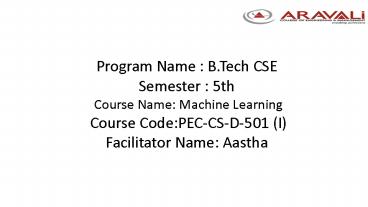Aravali college of Engineering and Management, Faridabad (5) - PowerPoint PPT Presentation
Title:
Aravali college of Engineering and Management, Faridabad (5)
Description:
Session on naive baye's classification – PowerPoint PPT presentation
Number of Views:7
Title: Aravali college of Engineering and Management, Faridabad (5)
1
Program Name B.Tech CSESemester 5th Course
Name Machine Learning Course CodePEC-CS-D-501
(I)Facilitator Name Aastha
2
Classification
3
Discussion on Classification by Naïve Bayes
4
Contents
? ? ? ?
What is Conditional Probability ? What is Bayes
Theorem? What is NAIVE BAYES CLASSIFIER? Types of
Naive Bayes Algorithm.
5
Classification as supervised learning
6
Unsupervised Classification
7
Conditional Probability
- In probability theory, conditional probability is
a measure of the probability of an event given
that another event has already occurred. - If the event of interest is A and the event B is
assumed to have occurred, "the conditional
probability of A given B", or "the probability of
A under the condition B", is usually written as
P(AB), or sometimes PB(A).
8
Examples
Chances of cough The probability that any given
person has a cough on any given day maybe only
5. But if we know or assume that the person has
a cold, then they are much more likely to be
coughing. The conditional probability of coughing
given that person have a cold might be a much
higher 75.
9
Marbles in a Bag
2 blue and 3 red marbles are in a bag. What are
the chances of getting a blue marble? ???
10
Marbles in a Bag
2 blue and 3 red marbles are in a bag. What are
the chances of getting a blue marble? Answer
- The chance is 2 in 5
11
Bayes Theorem
- In probability theory and statistics, Bayes
theorem (alternatively Bayes law or Bayes'
rule) describes the probability of an event,
based on prior knowledge of conditions that
might be related to the event. - For example, if cancer is related to age, then,
using Bayes theorem, a persons age can be used
to more accurately to assess the probability
that they have cancer, compared to the assessment
of the probability of cancer made without
knowledge of the person's age.
12
Classification by Bayes
13
The Formula for Bayes theorem
- where
- P(H) is the probability of hypothesis H being
true. This is known as the prior probability. - P(E) is the probability of the evidence(regardless
of the hypothesis). - P(EH) is the probability of the evidence given
that hypothesis is true. - P(HE) is the probability of the hypothesis given
that the evidence is there.
14
NAIVE BAYES CLASSIFIER
?
Naive Bayes is a kind of classifier which uses
the Bayes Theorem.
?
It predicts membership probabilities for each
class such as the probability that given record
or data point belongs to a particular class.
- The class with the highest probability is
considered as the most likely class. This is
also known as Maximum A Posteriori (MAP).
15
Assumption
Naive Bayes classifier assumes that all the
features are unrelated to each other. Presence
or absence of a feature does not influence the
presence or absence of any other feature. A
fruit may be considered to be an apple if it is
red, round, and about 4? in diameter. Even if
these features depend on each other or upon the
existence of the other features, a naive Bayes
classifier considers all of these properties to
independently contribute to the probability that
this fruit is an apple.
16
In real datasets, we test a hypothesis given
multiple evidence(feature). So, calculations
become complicated. To simplify the work, the
feature independence approach is used to
uncouple multiple evidence and treat each as
an independent one.
P(HMultiple Evidences) P(E1 H) P(E2H)
P(EnH) P(H) / P(Multiple Evidences)
17
Aravali College of Engineering And
Management Jasana, Tigoan Road, Neharpar,
Faridabad, Delhi NCR Toll Free Number 91-
8527538785 Website www.acem.edu.in

